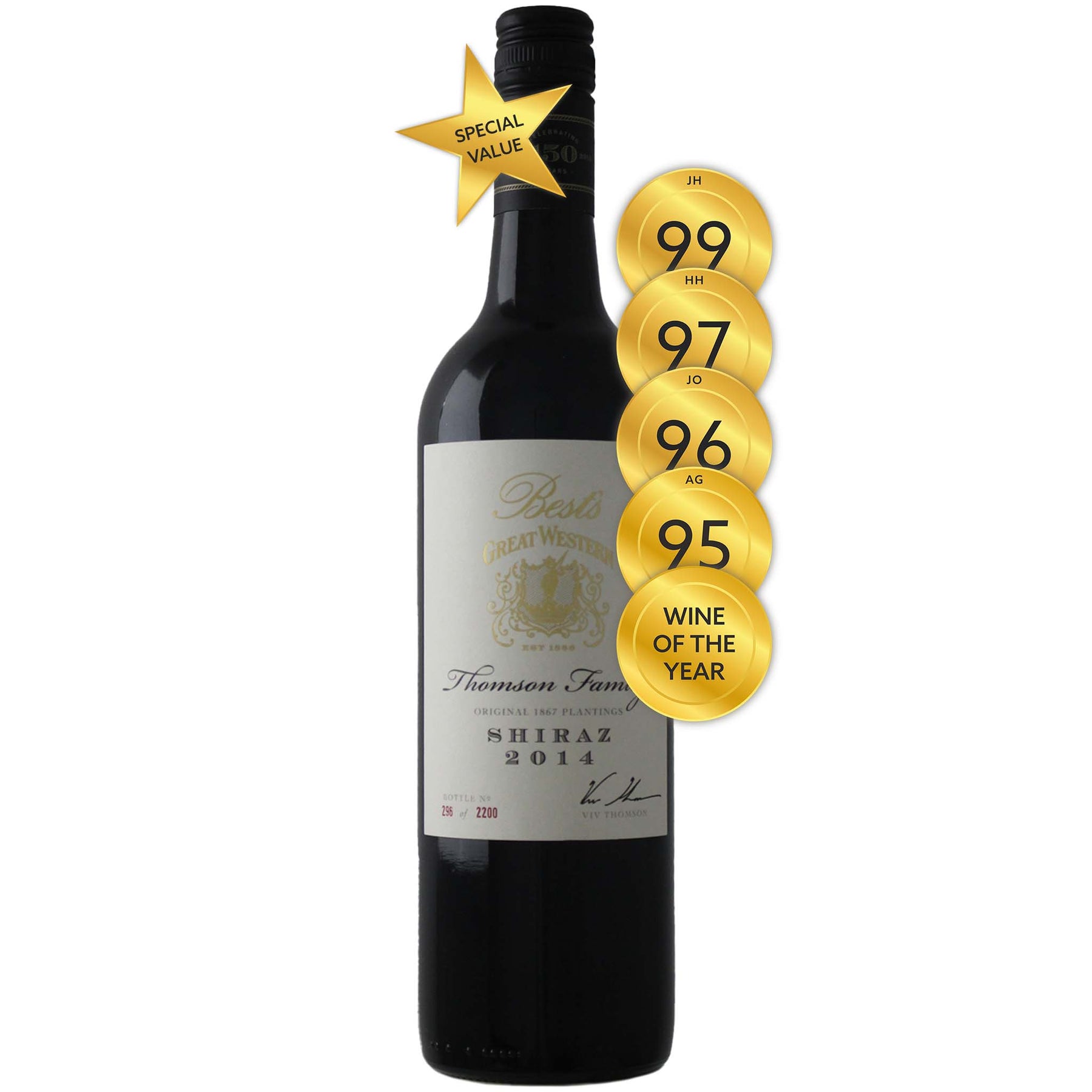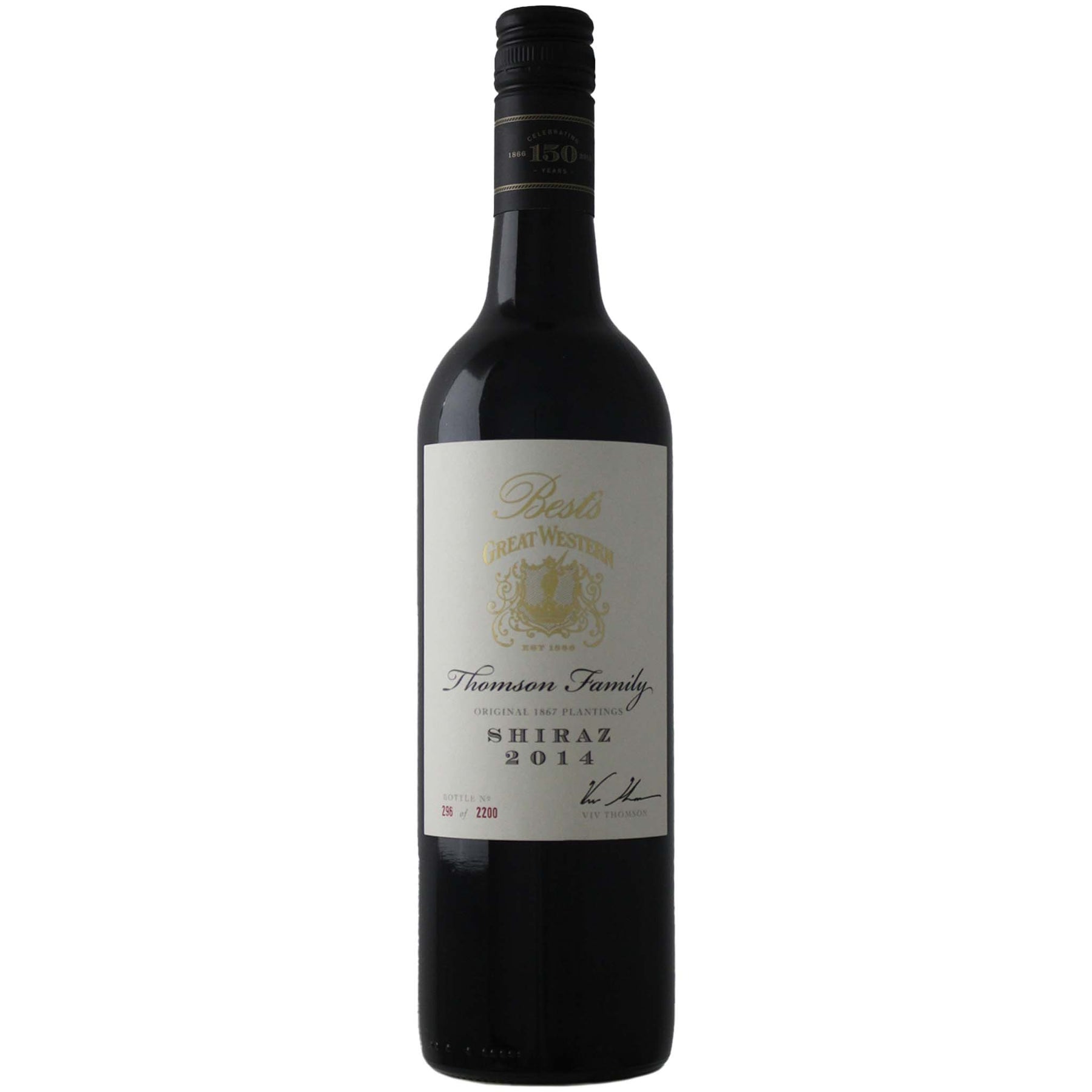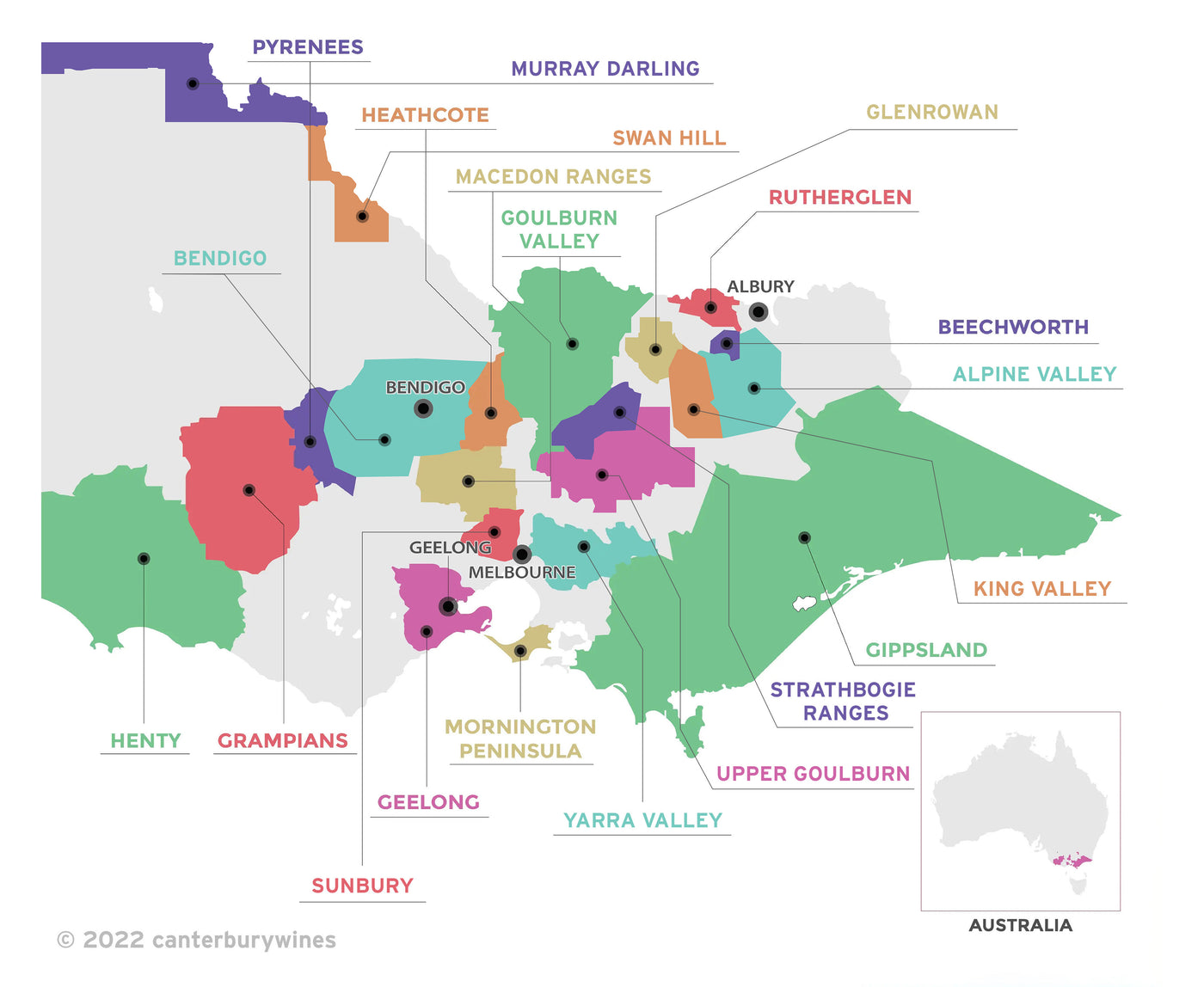

Best's Great Western Thomson Family Shiraz 2014
Style: Red Wine
Closure: Screwcap
Best's Great Western Thomson Family Shiraz 2014
Warehouse
34 Redland Drive
Vermont VIC 3133
Australia
Critic Score: 99
Alcohol: 13.5%
Size: 750 ml
Drink by: 2050
Halliday Wine Companion Wine Of the Year 2017
Best's Thompson Family Shiraz is one of the truly great wines of the world. The wine is made predominantly from fruit off fifteen rows of pre-phylloxera vines planted by Henry Best in the 1868. These rows that comprise the Thomson Family block are the oldest Shiraz vines in the historic Concongella Vineyard. Today the shiraz clone is referred to by the CSIRO as the Concongella clone or the Best's Old Block clone and it is the mother clone of all subsequent shiraz plantings at Best's Great Western.
Best's Thompson Family Shiraz is also one of the rarest with production being miniscule. In addition, it is only released in exceptional vintages. Sadly the ancient vines are slowly dying off, so the production slowly decreases with time. Some younger material from mature vines in the Concongella Vineyard (grown by cuttings taken from the old block) are included in the wine. That the wine is not 'stretched' with younger material is self-evident given the number of years it is not made at all, and that 2200 bottles were made in 2014, compared with (for example) 4200 in 2010. However, there will come a time when the wine will be no more.
"The palate is full-bodied and powerful, with fruit sweetness and tangy acid buried beneath masses of tannin, which firms up the finish. It's youthful, undeveloped and still emerging. It desperately needs time. It's a nascent wine of great potential which has been released far too young. Cellar it. It's a great wine." Huon Hooke
Jeremy Oliver allocates the highest possible ranking of 1 to only three Australian shiraz - Penfolds Grange, Henschke Hill of Grace and Best's Thomson Family. Of the Thomson Family he says: "Sourced from some of Australia's oldest shiraz vines, this wine is about intensity and purity of dark, spicy fruit, style, elegance and a wonderfully tight-knit and fine-grained backbone."
Expert reviews
"Bottle no. 39 of 2200 tells part of the story, but the front label also has in demure typeface 'original 1867 plantings'. This is a ravishing wine with a velvet and satin mouthfeel, and a rainbow of black, purple and blue fruits. Supple tannins are somewhere in the mix, likewise French oak, but don't bother dissecting what is an exquisite wine. As a point of principle, I'm not going to give 100 points for a table wine, but if I were, this would get the nod. Drink by 2054.
It is commonplace for wineries to release an icon wine for the first time saying it will only be released in the best vintages, but then releasing it virtually every year. Since 1992 (the first release), this wine has been made in 14 vintages, and not made in nine. Indeed, since 1999 it has only been made every second year.
It's obvious that the self-set standards have been stricter with a succession of highly qualified winemakers, none more so than present incumbent Justin Purser (and before him, Adam Wadewitz). The fruit selection is rigorous; some of the fruit from the 15 rows was discarded, replaced by fruit from mature vines grown by cuttings taken from the old block. That the wine is not 'stretched' with younger material is self-evident given the number of years it is not made at all, and that 2200 bottles were made in 2014, compared with (for example) 4200 in 2010.
It is open-fermented in small tubs, and matured for 18–24 months in French oak; there is no recipe for the percentage, nor for the percentage of new oak (usually around 50%, but can be higher). It is handled with kid gloves in the winery. It is a truly glorious wine." James Halliday, Halliday Wine Companion - 99 points and 2017 Wine of the Year and Special Value Wine ★
"Deep, very youthful purple/red colour. The bouquet opens with strong coconutty oak, with black fruits, espresso coffee and smoky, roasting pan complexities. The palate is full-bodied and powerful, with fruit sweetness and tangy acid buried beneath masses of tannin, which firms up the finish. It's youthful, undeveloped and still emerging. It desperately needs time. It's a nascent wine of great potential which has been released far too young. Cellar it. (This bottle was drinking best after being open for two days, a sure sign of long-term aging potential.) It's a great wine. Drink: 2023–2051." Huon Hooke, The Real Review - 97 points
"A deeply flavoured and exotically spiced shiraz whose peppery, floral bouquet of pristine blackcurrants, mulberries and dark plums has a musky, cedary background and a hint of earthiness. Medium to full-bodied, it's long and luscious, retaining elegance along its fine, tightly crafted palate of pristine fruit, crunchy fine tannins and meaty undertones. Finishing spicy and savoury, it's likely to build richness and weight as it ages, becoming more meaty and leathery." Jeremy Oliver - 96 points
"Exclusively sourced from the original 1867 Thomson Family Block, this is open fermented, basket pressed and spends 24 months in oak. Under screwcap, this may well live forever – the inaugural 1992 was still looking good back in 2012 and I have no doubt this 2014 will be in rude health come 2036. Interesting to see that the colour is deeper than the Bin 0 – it's a deeper purple. This is more intense, more fragrant and even more impressive than the very good Bin 0, a step up from Business to First Class. There's more oak, less overt purple fruit sweetness, and a more chunky feel – it's thicker all round. That helps integrate the acidity too, giving the whole wine a different character, much more seriousness. The key takeaway is just how balanced it is – immediately swish and powerful and modern, but with a core of rich fruit and wow length. This tastes like special wine, regardless of the pricetag. Heck, you could even drink it now! Best drinking: 2016-2036+. Would I buy it? Please somebody buy me some." Andrew Graham, Australian Wine Review - 95 points
Awards
Halliday Wine Companion Wine Of the Year 2017
Special Value Wine – Halliday Wine Companion ★
Thomson family block

The dry-grown vines of the historic Thomson Family block comprise fifteen rows of pre-phylloxera vines in the Concongella Vineyard that were planted by Henry Best in 1868. In great vintages, all the fruit goes into the Thomson Family Shiraz. If the fruit doesn't make the grade, it is used selectively in Bin 0.
In the old days, the Thomson Family block was known as two separate sections: one was known as "11 rows” and the other as "four rows” (also called the "pigsty vineyard” due to the fact that the pigsty used to be beside the vineyard). The vines are picked separately to keep the rows apart. A lot of time has been spent mulching heavily around the vines with straw to help retain moisture and encourage healthy bug activity, and they're now looking fantastic.
These gnarled old vines in the oldest Shiraz vineyard grow in soils that range from hard-setting silt over clay to friable clay loams. The dry-grown have roots that penetrate several metres down deep into the earth, bringing extra complexity and intensity to the wines.
About the winery

The story
The story of Best's begins in 1866 when Henry Best purchases 30ha of land in the small town of Great Western. It was a property named Concongella. Henry planted the first vines in 1868. Best's original vineyards are among the oldest and rarest pre-phylloxera plantings in the world. The Nursery Block contains 39 varieties that are thought to be sourced from the Busby collection, Australia's first vines. A number of the vines planted in the Nursery Block have defied identification and are thought to exist nowhere else in the world.
In the early 20th century, Henry Best presents his wines throughout Europe and was awarded gold medals in Paris, Bordeaux, Brussels and London. In 1913 Henry Best dies, age 81, and is buried in the Great Western Cemetery.
In 1920 the Thompson Family purchases the Concongella Vineyard from the Best family. The Thompson Family had originally settled in Great Western in 1893 and purchased a winery at Rhymney (13km south of Henry Best).
In 1961 Viv Thomson joins his family for his first vintage. In 1967 Best's Old Vine Pinot Meunier was first produced. In 1975 Viv decided to appoint the first external winemaker, Trevor Mast. Best's had grown significantly and Viv was needed to manage the company and develop relationships further afield.
The 1992 vintage of the flagship Thomson Family Shiraz is first released in 1993 to commemorate 100 years since the Thomson family settled in Great Western. In 2000 Best's cornerstone wine, Bin No. 1 Shiraz, is made for the first time.
In 2008 Viv Thomson hands over the reins of the company to his son Ben. In 2020 the Thomson Family celebrates 100 years as custodians of Best's Wines.
Notable Awards
2011 Best's Bin 1 Shiraz wins the Jimmy Watson Memorial Trophy at the 2012 Royal Melbourne Wine Show.
2014 Best's Thomson Family Shiraz wins the 2017 Halliday Wine of the Year.
Langton's classifies Best's Thomson Family Shiraz as 'Exceptional' and Best's Bin 0 Shiraz as 'Outstanding' in 2018
Best's awarded Best Value Winery of the Year in James Halliday's 2021 Wine Companion.
2021 Foudre Ferment Riesling wins the 2023 Halliday Wine of the Year.

Victoria
Victoria is home to more than 800 wineries across 21 wine regions. The regions are Alpine Valley, Beechworth, Bendigo, Geelong, Gippsland, Glenrowan, Goulburn Valley, Grampians, Heathcote, Henty, King Valley, Macedon Ranges, Mornington Peninsula, Murray Darling, Pyrenees, Rutherglen, Strathbogie Ranges, Sunbury, Swan Hill, Upper Goulburn and Yarra Valley.
Victoria's first vines were planted at Yering in the Yarra Valley in 1838. By 1868 over 3,000 acres had been planted in Victoria, establishing Victoria as the premier wine State of the day. Today, the original vineyards planted at Best's Wines are among the oldest and rarest pre-phylloxera plantings in the world.
Victoria's climate varies from hot and dry in the north to cool in the south and each wine region specialises in different varietals. For example, Rutherglen in the north is famous for its opulent Muscats and Topaque and bold reds, while the many cooler climate regions near Melbourne produce world class Chardonnay and pinot Noir. Victoria is truly a wine lover's playground.

